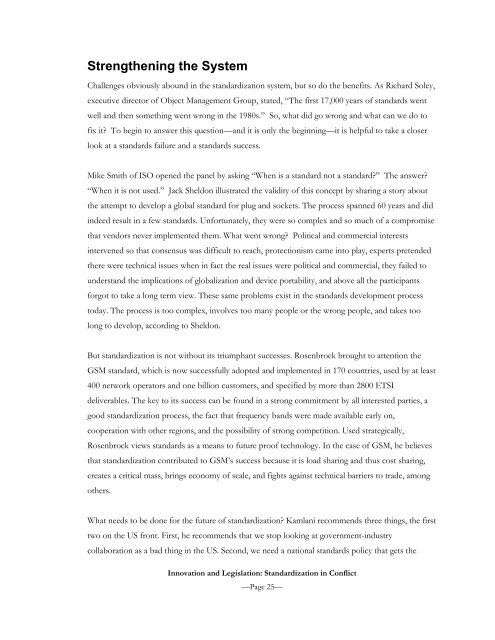Innovation and Legislation: Standardization in ... - The Bolin Group
Innovation and Legislation: Standardization in ... - The Bolin Group
Innovation and Legislation: Standardization in ... - The Bolin Group
Create successful ePaper yourself
Turn your PDF publications into a flip-book with our unique Google optimized e-Paper software.
Strengthen<strong>in</strong>g the System<br />
Challenges obviously abound <strong>in</strong> the st<strong>and</strong>ardization system, but so do the benefits. As Richard Soley,<br />
executive director of Object Management <strong>Group</strong>, stated, “<strong>The</strong> first 17,000 years of st<strong>and</strong>ards went<br />
well <strong>and</strong> then someth<strong>in</strong>g went wrong <strong>in</strong> the 1980s.” So, what did go wrong <strong>and</strong> what can we do to<br />
fix it? To beg<strong>in</strong> to answer this question—<strong>and</strong> it is only the beg<strong>in</strong>n<strong>in</strong>g—it is helpful to take a closer<br />
look at a st<strong>and</strong>ards failure <strong>and</strong> a st<strong>and</strong>ards success.<br />
Mike Smith of ISO opened the panel by ask<strong>in</strong>g “When is a st<strong>and</strong>ard not a st<strong>and</strong>ard?” <strong>The</strong> answer?<br />
“When it is not used.” Jack Sheldon illustrated the validity of this concept by shar<strong>in</strong>g a story about<br />
the attempt to develop a global st<strong>and</strong>ard for plug <strong>and</strong> sockets. <strong>The</strong> process spanned 60 years <strong>and</strong> did<br />
<strong>in</strong>deed result <strong>in</strong> a few st<strong>and</strong>ards. Unfortunately, they were so complex <strong>and</strong> so much of a compromise<br />
that vendors never implemented them. What went wrong? Political <strong>and</strong> commercial <strong>in</strong>terests<br />
<strong>in</strong>tervened so that consensus was difficult to reach, protectionism came <strong>in</strong>to play, experts pretended<br />
there were technical issues when <strong>in</strong> fact the real issues were political <strong>and</strong> commercial, they failed to<br />
underst<strong>and</strong> the implications of globalization <strong>and</strong> device portability, <strong>and</strong> above all the participants<br />
forgot to take a long term view. <strong>The</strong>se same problems exist <strong>in</strong> the st<strong>and</strong>ards development process<br />
today. <strong>The</strong> process is too complex, <strong>in</strong>volves too many people or the wrong people, <strong>and</strong> takes too<br />
long to develop, accord<strong>in</strong>g to Sheldon.<br />
But st<strong>and</strong>ardization is not without its triumphant successes. Rosenbrock brought to attention the<br />
GSM st<strong>and</strong>ard, which is now successfully adopted <strong>and</strong> implemented <strong>in</strong> 170 countries, used by at least<br />
400 network operators <strong>and</strong> one billion customers, <strong>and</strong> specified by more than 2800 ETSI<br />
deliverables. <strong>The</strong> key to its success can be found <strong>in</strong> a strong commitment by all <strong>in</strong>terested parties, a<br />
good st<strong>and</strong>ardization process, the fact that frequency b<strong>and</strong>s were made available early on,<br />
cooperation with other regions, <strong>and</strong> the possibility of strong competition. Used strategically,<br />
Rosenbrock views st<strong>and</strong>ards as a means to future proof technology. In the case of GSM, he believes<br />
that st<strong>and</strong>ardization contributed to GSM’s success because it is load shar<strong>in</strong>g <strong>and</strong> thus cost shar<strong>in</strong>g,<br />
creates a critical mass, br<strong>in</strong>gs economy of scale, <strong>and</strong> fights aga<strong>in</strong>st technical barriers to trade, among<br />
others.<br />
What needs to be done for the future of st<strong>and</strong>ardization? Kamlani recommends three th<strong>in</strong>gs, the first<br />
two on the US front. First, he recommends that we stop look<strong>in</strong>g at government-<strong>in</strong>dustry<br />
collaboration as a bad th<strong>in</strong>g <strong>in</strong> the US. Second, we need a national st<strong>and</strong>ards policy that gets the<br />
<strong>Innovation</strong> <strong>and</strong> <strong>Legislation</strong>: St<strong>and</strong>ardization <strong>in</strong> Conflict<br />
—Page 25—









